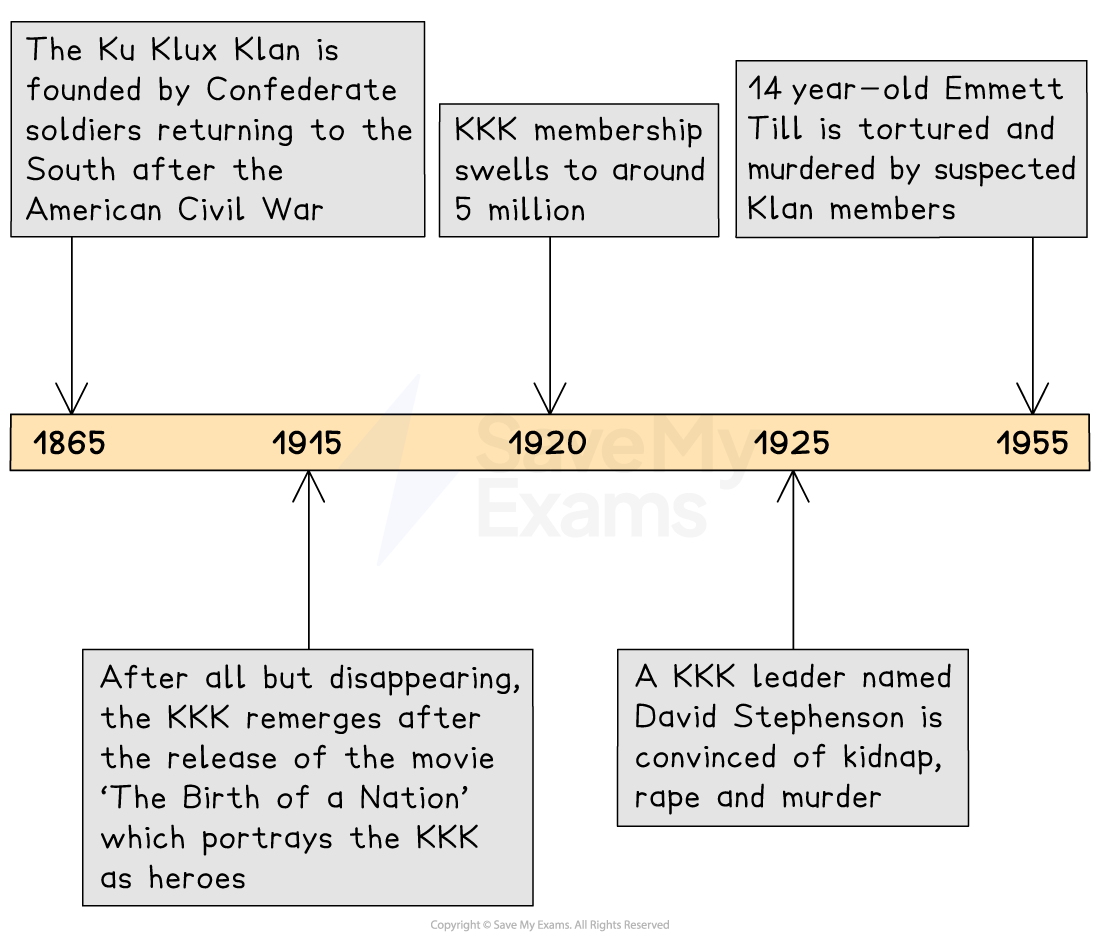Opposition to the Civil Rights Movement (Edexcel GCSE History): Revision Note
Exam code: 1HI0
Timeline

Summary
The civil rights movement faced opposition from several areas. Some opposition, such as the Ku Klux Klan, used deadly violence to maintain segregation. Others used political means to argue in Congress and in the Senate that it was up to the individual states to decide on their laws. They did not believe that the national government should interfere in state laws.
What was the Ku Klux Klan (KKK)?
The Ku Klux Klan was a secretive racist organisation
Its members hid their identities at Klan meetings by wearing long white robes with pointed hoods that completely concealed their faces
Klan members were White protestant Americans who believed they were superior to Black people and should therefore be in charge of Black Americans
White protestant Americans sometimes referred to themselves as WASPS which stands for White Anglo-Saxon Protestants and refers to their British or German ancestry
The Klan members terrorised Black Americans through beatings and lynchings
A lynching involves executing a person, normally by hanging from a tree, for an alleged crime without the victim having a trial
Often, the victim’s bodies were then mutilated by covering them in tar and feathers
Between 1882 and 1968, there were around 5,000 recorded lynchings in the South
Punishment for these crimes was extremely rare as judges and police officers were often members of the KKK
AWAITING IMAGE
Who was Emmett Till?
Emmett Till was a 14-year-old Black boy from Chicago who was murdered in Mississippi in 1955
There was no segregation where he came from in the North but he was killed whilst visiting his cousins in the South
Why was Emmett Till murdered?
Emmett Till was accused of flirting with, whistling at and touching the white 21-year-old wife of store owner Roy Bryant
Several nights later, Bryant and his half-brother, J.W. Milam, abducted Till at gunpoint from his uncle’s house
His body was discovered floating in a river days later, having been severely beaten and shot in the head
The significance of Emmett Till to the civil rights movement
Emmett Till’s mother decided to have an open casket at his funeral and photographs of his mutilated face were published by many national newspapers
The images and story of the boy’s death caused an uproar and Bryant and Milam were arrested
They became the first white men ever to be charged with the murder of a Black person in Mississippi
When Bryant and Milam stood trial, an all-white jury took less than one hour to find them not guilty
Bryant and Milam then sold their story to a magazine for an enormous sum of money
The trial generated anger and publicity, leading many more people to become sympathetic to and involved with the civil rights movement
This included Black and White Americans
The killers of Emmett Till, along with the local police, were believed to be members of the KKK and were never punished
Opposition to civil rights: Congress
The success of the civil rights movement in challenging segregation led to a furious response from politicians who were opposed to it
This opposition increased after the ruling in the court case of Brown v. Topeka, which stated that segregation in schools went against the constitution
In Congress, 19 senators and 77 members of the House of Representatives declared the Brown v.Topeka ruling “a clear abuse of judicial power”
They believed that the Federal government had no right to interfere in an individual state’s education policy
The politicians all signed the Southern Manifesto, which encouraged states to resist any changes to improve civil rights
Opposition to civil rights: Dixiecrats
There are two main political parties in the United States; the Republican Party and the Democratic Party
The civil rights movement caused deep divisions within the Democratic Party
Democrats from the South who were opposed to ending segregation became known as Dixiecrats
The term comes from combining the words ‘Dixieland’, which is a nickname for the South, and Democrat
Their numbers meant they were influential, and they frequently slowed or prevented new civil rights laws from being passed
Dixiecrats claimed that they weren’t racist because their opposition was about the principle of states deciding on their own laws, rather than the Federal government
Examiner Tips and Tricks
Learning subject-specific terms makes your answer clearer and gives them extra authority. Using the term ‘Dixiecrat’ instead of ‘Democrats who opposed ending segregation’, tells the examiner that you have a firm understanding of the subject content.

You've read 0 of your 5 free revision notes this week
Unlock more, it's free!
Did this page help you?